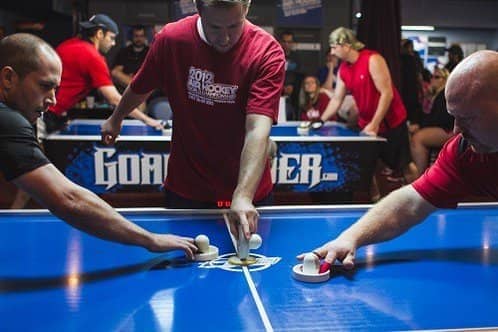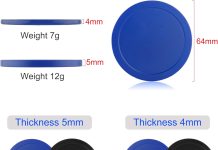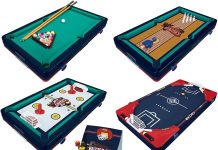Let’s settle the ongoing debate once and for all – does air hockey require skill?
Whether you’ve had sweaty battles with friends at the arcade or simply wondered if it’s all about luck, this captivating article will shed light on the true essence of this beloved game.
Strap on your wristbands, grab your favorite puck and get ready to uncover the surprising level of finesse, strategy, and sheer talent that air hockey demands.
Prepare to be amazed at the intricacies behind those lightning-fast reflexes and puck movements that make this game unique and addictive.
Review contents
Rules of Air Hockey
Basic rules of air hockey
Air hockey is a fast-paced and exciting game that requires skill and precision to outmaneuver your opponent. The basic rules of air hockey are pretty simple. The game is played on a specially designed table with a smooth playing surface and air jets that provide cushioning for the puck to glide on. Two players stand at opposite ends of the table, each holding a paddle. The game aims to score points by hitting the puck into the opponent’s goal while defending your own. The player who reaches a predetermined score first is the winner.
Scoring in air hockey
Scoring in air hockey is straightforward. A point is awarded to the player who successfully hits the puck into the opponent’s goal. However, there are some essential guidelines to remember. For a goal to count, the puck must entirely cross the goal line and not touch any part of the player’s hand, body, or paddle.
Additionally, a point cannot be scored if the offensive player strikes the puck after crossing the centerline. This rule prevents players from gaining an unfair advantage by “cherry-picking” near the opponent’s goal.
Penalties in air hockey
While air hockey is generally a non-contact sport, there are rules to maintain fair play and prevent unnecessary roughness. If a player deliberately interferes with their opponent’s shot or obstructs their movements, a penalty may be called.
Common penalties in air hockey include touching the puck with anything other than the paddle, jostling or moving the table, intentionally blocking the opponent’s view, and reaching over the centerline while in possession. Penalties result in the offending player’s loss of possession and potentially a point deduction, depending on the severity of the offense.
Techniques and Strategies
Grip and hand positioning
One of the most fundamental aspects of air hockey is the grip and hand positioning. A proper grip allows for better paddle control, power, and maneuverability. The most common grip is the handshake grip, where you hold the paddle as if shaking someone’s hand.
This grip provides stability and flexibility to react quickly to the puck’s movements. Hand positioning is equally important, with the non-dominant hand as a guide to help with accuracy and coordination. Maintaining a balanced grip and proper hand positioning gives you a solid foundation for executing various shots and defensive maneuvers.
Puck control
Mastering puck control is essential in air hockey to outmaneuver your opponent consistently. The key is to use controlled strokes and quick movements to keep the puck on your side of the table while setting up offensive opportunities.
Different techniques can improve puck control, such as using short strokes for precise movements, angling the paddle to redirect the puck’s trajectory, and utilizing quick wrist flicks to change the puck’s direction. With practice and experience, you’ll be able to maintain better control over the puck, making it harder for your opponent to intercept or steal possession.
Offensive strategies
Developing effective offensive strategies is crucial in maximizing your scoring opportunities. One popular offensive strategy is the “dump and chase,” where you shoot the puck deep into the opponent’s corner and quickly pursue it to maintain pressure.
This strategy creates chaos for the opposing player, forcing them to react and potentially make mistakes. Another strategy is the “pass and shoot,” where you strategically pass the puck between your paddles to confuse the opponent’s defense before taking a well-aimed shot. The key to a successful offense is a combination of speed, accuracy, and creativity.
Defensive strategies
In air hockey, defense is just as important as offense. A solid defense can thwart your opponent’s scoring attempts and provide counterattack opportunities. One standard defensive strategy is the “centerline defense,” where you effectively position yourself near the centerline to cover both sides of the table.
You can quickly react to shots from either direction by staying close to the centerline. Another strategy is the “block and counter,” where you focus on blocking the opponent’s shots and immediately transition into a counterattack. These defensive strategies require reasonable anticipation, quick reflexes, and the ability to read your opponent’s moves.
Physical Demands
Hand-eye coordination
Air hockey demands excellent hand-eye coordination to react quickly to the constantly moving puck. Good hand-eye coordination lets you accurately track the puck’s movements and position your paddle accordingly.
This skill becomes even more critical as you progress to higher skill levels, where opponents employ faster shots and more deceptive strategies. Regular practice and training can help improve hand-eye coordination, enabling you to anticipate the puck’s trajectory and react quickly and accurately.
Reflexes and reaction time
Air hockey is a game of split-second decisions requiring exceptional reflexes and reaction time. The ability to quickly process incoming information and respond accordingly is vital in air hockey.
Whether it’s deflecting a powerful shot or launching a counterattack, your reflexes and reaction time play a crucial role in your success on the table. Through practice drills and exercises that focus on reacting to different situations, you can sharpen your reflexes and improve your reaction time, gaining a competitive edge over opponents.
Quick movements and agility
Air hockey demands quick movements and agility to cover the table and effectively respond to opponents’ shots. You must change positions swiftly, reach for the puck, and precisely execute shots.
Agility helps maintain balance while making rapid movements and allows you to adjust your positioning based on the puck’s movement. Exercises such as footwork drills, lateral movement exercises, and agility training can help improve your quickness and overall agility on the air hockey table.
Equipment
Air hockey table
The air hockey table is the game’s centerpiece, providing a smooth playing surface and air cushion that allows the puck to glide effortlessly. Tables can vary in size and design, but they generally contain a large rectangular surface with low sidewalls to contain the puck.
The surface is made from a durable material, such as laminated wood or acrylic, to withstand fast-paced gameplay. Quality air hockey tables also feature powerful air blowers evenly distributing air across the surface, creating a consistent and frictionless playing experience.
Air hockey paddle
The air hockey paddle, a striker or mallet, is the primary tool for striking the puck. Paddles are typically made of plastic and have a flat bottom surface with a small handle.
They come in various shapes, sizes, and weights to suit different player preferences. Paddle design, such as the presence of vents or ridges, can also impact gameplay. Choosing a paddle that feels comfortable in your hand and allows for optimal control and maneuverability on the table is essential.
Air hockey puck
The air hockey puck is a round, flat disc made of plastic. The puck’s bottom surface is smooth to enable frictionless movement on the table surface. Pucks come in different sizes and weights, with regulation-sized pucks being approximately three inches in diameter.
The lightweight design of the puck, combined with the cushion of air provided by the table, allows for high-speed gameplay and facilitates swift movements. Using a high-quality puck that glides smoothly is essential to ensure fair play and enjoyable gameplay.
Practice
Muscle memory
Like any skill-based activity, air hockey requires practice to develop muscle memory. Muscle memory allows you to perform specific movements and techniques without conscious thought, enabling quick and accurate execution.
Through regular practice sessions, your muscles become accustomed to the repetitive motions involved in air hockey, such as stroking the puck, blocking shots, and changing positions on the table. Over time, muscle memory helps you instinctively react to different game situations, improving your overall performance.
Speed and accuracy
Practicing speed and accuracy is crucial in air hockey, as it directly translates to your ability to score goals and defend against your opponent’s shots. Speed training focuses on increasing the velocity of your shots and movements, allowing you to catch your opponent off guard and create scoring opportunities.
Accuracy training, on the other hand, emphasizes hitting specific targets on the opponent’s side of the table, improving your ability to place shots precisely where you want them. You can enhance your overall gameplay skills by dedicating time to both speed and accuracy drills during practice sessions.
Strategy development
Practice sessions also allow you to develop and refine your air hockey strategies. Experimenting with different offensive and defensive tactics during practice allows you to understand what works best for your style of play. By analyzing your opponents’ strengths and weaknesses, you can tailor your strategies to exploit their vulnerabilities and minimize their scoring opportunities.
Additionally, practice sessions with partners or coaches offer valuable feedback and insights that can contribute to strategy development. Continual practice and strategic refinement lead to a more well-rounded and adaptable playing style.
Competition Level
Recreational play
Air hockey is enjoyed by players of all skill levels, and recreational play is a popular way to have fun with family and friends. In a recreational setting, the focus is less on highly competitive play and more on enjoyment and friendly competition.
The rules can be more relaxed, allowing for casual gameplay and flexibility. Recreational air hockey offers a relaxed introduction to the game and allows players of varying skill levels to learn and improve at their own pace.
Amateur competitions
Amateur air hockey competitions provide a platform for players to showcase their skills and compete against others in a more structured environment. These competitions often have standardized rules and regulations, closely resembling the professional level of play.
Amateur players compete for trophies, prizes, and personal satisfaction to improve their rankings and establish themselves within the air hockey community. Competing at the amateur level allows players to gauge their abilities, gain experience, and potentially progress to higher levels of competition.
Professional tournaments
At the pinnacle of air hockey competition are professional tournaments, where top players worldwide gather to compete for substantial prize money and recognition. Professional air hockey tournaments are hosted by organizations such as the US Air Hockey Association (USAA) and the International Table Hockey Federation (ITHF).
These tournaments attract highly skilled players who have devoted years to honing their craft and mastering the game’s intricacies. Professional air hockey offers an elevated level of competition, showcasing the sport’s highest level of skill, strategy, and intensity.
Comparing Skill Levels
Beginner
Beginner air hockey players are just starting their journey in the game and are typically learning the basic rules and techniques. At this stage, players may struggle with control and accuracy, often resorting to random shots and relying heavily on reflexes.
Beginners benefit from consistent practice and guidance, gradually building their skills and improving their understanding of the game. With time and dedication, beginners can progress to intermediate levels by developing better control, more vital shots, and a more tactical approach to gameplay.
Intermediate
Intermediate air hockey players have a solid grasp of the game’s fundamentals and have developed a level of consistency in their play. They can execute primary offensive and defensive strategies, displaying improved control over the puck and showcasing greater accuracy in their shots.
Intermediate players often seek opportunities to refine their skills, experiment with different strategies, and compete in amateur-level competitions to measure their progress. Continued practice and exposure to higher-level competition can help intermediate players transition to advanced levels.
Advanced
Advanced air hockey players are the crème de la crème of the sport, characterized by their exceptional skills, strategic thinking, and consistent performance in high-level competitions. They possess superior control over the puck, lightning-fast reflexes, and the ability to read their opponent’s moves.
Advanced players excel in the game’s offensive and defensive aspects, employing intricate strategies and executing shots with pinpoint accuracy. These players continually push the boundaries of their skills and contribute to the growth and evolution of air hockey as a professional sport.
Expert Opinions
Views of professional air hockey players
Professional air hockey players have spent countless hours practicing and competing at the highest level, making their opinions highly valuable. Many professionals emphasize the importance of practice, strategy, and mental focus in achieving success in air hockey.
They stress needing a well-rounded skill set encompassing puck control, speed, accuracy, and adaptability. Professionals also highlight the significance of understanding opponents’ tendencies, exploiting weaknesses, and continually evolving gameplay to stay competitive in a dynamic sport like air hockey.
Coaches and trainers’ insights
Coaches and trainers play a vital role in developing air hockey players’ skills and guiding them on their journey. They bring a wealth of knowledge and experience, providing valuable insights and specialized training techniques.
Coaches often emphasize the importance of discipline, dedication, and attention to detail in reaching one’s full potential. They assist players in refining their techniques, developing personalized strategies, and optimizing physical and mental attributes. Coaches and trainers serve as mentors and motivators, nurturing the growth of players and helping them unlock their full capabilities.
Development of Skill
Learning curve
Mastering air hockey can be a challenging and rewarding journey. The learning curve varies for each individual, depending on their prior experience, physical abilities, and dedication to practice. Beginners may quickly pick up the game’s basic mechanics but require focused practice to develop control, accuracy, and strategy.
As players progress through different skill levels, the learning curve becomes steeper, necessitating more intensive training and strategic refinement. However, with perseverance and a growth mindset, anyone can continue advancing their skills and enjoying the game.
Improvement over time
Improvement in air hockey is a gradual process that occurs over time with consistent practice and dedication. As players accumulate hours of practice and gain experience in various game situations, their skills naturally improve.
Initially, progress may be seen in small increments, such as better control over the puck or increased shooting accuracy. Over time, these incremental improvements compound, leading to noticeable advancements in overall gameplay. Improvement in air hockey is a testament to the power of deliberate practice and the individual’s commitment to self-improvement.
Factors influencing skill development
Several factors influence skill development in air hockey. Firstly, deliberate and focused practice is crucial for honing specific skills, perfecting techniques, and developing strategies. Regular practice sessions, combined with feedback and guidance from coaches and trainers, facilitate skill development.
Physical attributes, such as hand-eye coordination, reflexes, and agility, also play a significant role. Additionally, a player’s mindset, willingness to learn from mistakes, and adaptability to different opponents’ styles can significantly impact skill development.
Overall, a combination of practice, physical attributes, and mental fortitude contributes to the growth and mastery of air hockey skills.
Conclusion
Air hockey is undoubtedly a game that requires skill, dedication, and practice to excel. From the basic rules to advanced strategies, players must master various techniques encompassing grip, puck control, and offensive and defensive maneuvers—the physical demands of air hockey test hand-eye coordination, reflexes, and agility.
The equipment, including the table, paddle, and puck, must be well-suited to facilitate fair play and optimal performance. As players progress through different skill levels, from recreational to amateur and professional, they experience gradual improvement and face stiffer competition.
The insights of experts, including professional players and coaches, provide valuable perspectives on the game. At the same time, skills development is a continuous journey influenced by factors such as practice, experience, physical attributes, and mindset.
So, pick up the paddle, hone your skills, and embrace the excitement and challenge that air hockey offers.




























![Best Outdoor Dartboards [Reviews and Buying Guide 2024] Best Outdoor Dartboards](https://gamersets.com/wp-content/uploads/2022/12/Best-Outdoor-Dartboards-100x70.jpg)

![Best Mini Air Hockey Table [Reviews & Buying Guide 2024] Best mini air hockey table](https://gamersets.com/wp-content/uploads/2022/10/Best-mini-air-hockey-table-100x70.jpg)







